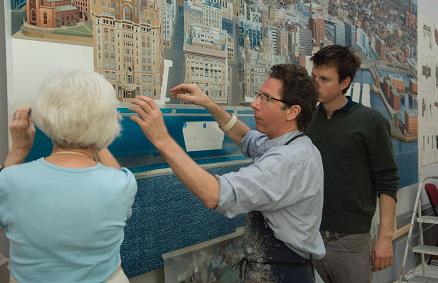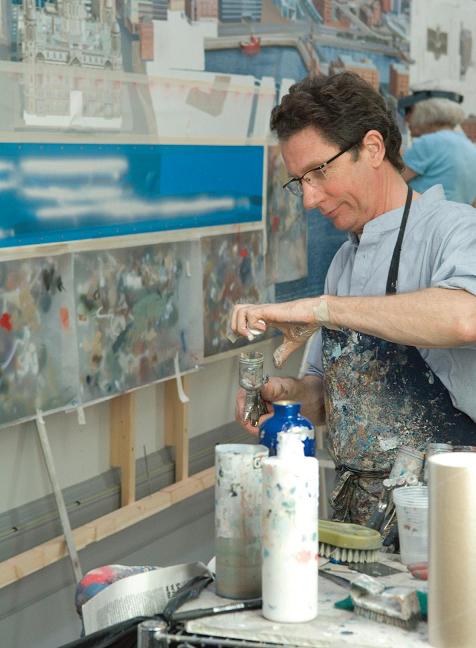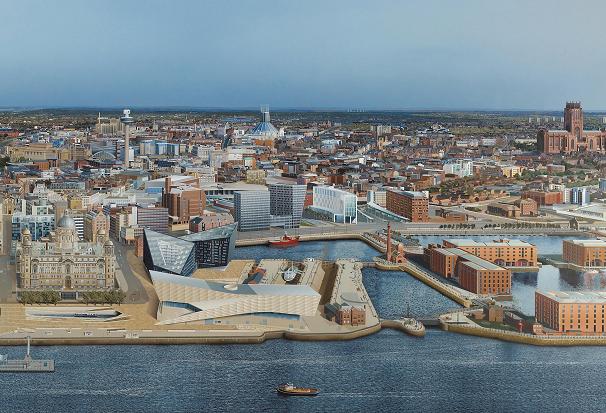Artist chooses precision cutting plotter to help create Liverpool Cityscape
 When British artist Ben Johnson was commissioned to produce a portrait of the city of Liverpool, he created a stunning cityscape – and vital to completing the finished work in time was a Graphtec FC4100 cutting plotter.
When British artist Ben Johnson was commissioned to produce a portrait of the city of Liverpool, he created a stunning cityscape – and vital to completing the finished work in time was a Graphtec FC4100 cutting plotter.
Ben Johnson was born in Llandudno, Wales, studied at the Royal College of Art in London, and had his first solo exhibition in 1969 at the Wickesham Gallery, New York. In 1990 he was made an honorary Fellow of the Royal Institute of British Architects, the only contemporary painter to be so honoured, for his contribution to the public understanding of contemporary architecture. Today, he is an internationally-renowned artist with work in private and public collections across the world.
The Liverpool Cityscape was commissioned by National Museums Liverpool, with the Liverpool Culture Company and Professor Phil Redmond CBE and Alexis Redmond, in celebration of Liverpool being European City of Culture for 2008.
The remarkable detail in the picture is typical of Ben’s work. This is achieved by cutting thousands of differently shaped and sized stencils, assembling the stencils in layers, spray painting and hand-finishing with small sable brushes. Ben has been using the Graphtec FC4100 cutter in his work for five years.

He explains: "Before I had the Graphtec I was cutting out stencils by hand with a scalpel. But then I thought ‘signwriters cut letters and intricate shapes all the time and they don’t do it by hand, surely I could use what they use’. So I approached five companies and tested five different machines. The one with the greatest accuracy was the Graphtec, and I chose that."
Even using the automated cutter, producing a cityscape is a time-consuming and labour intensive task. The Liverpool Cityscape took three years to complete with Ben and six assistants working full time, and others, including students, friends and volunteers, helping at different stages. It is Ben’s largest work, 8ft x 16ft, and most complex to date and is calculated to have taken in excess of 24,000 person hours.
The lengthy process starts by Ben considering different views of the city and deciding which he wants to represent. In Liverpool, he chose a vista of the city’s famous skyline from a point high above the River Mersey. The area covers 170 hectares, includes both of the city’s football grounds and shows the extent of redevelopment in recent years.
Where some artists make sketches, Ben takes photos, and a lot of them. For this project he took approximately 3,500. He also consulted with architects and historians, as well as the people of Liverpool, to get a real feel of the city’s individual character.
Using his photos, Ben directed a team of three draughts people in making a grid on which to individually reconstruct each building, or groups of buildings such as terraces. They were recreated using traditional perspective, rather than vectorisation by a PC. This stage generated 1,500 sets of individual drawings, equivalent to around nine years of full-time work for a single draughtsperson.
From those drawings some 23,000 vinyl stencils, not counting foliage, landscape and water, were cut, which is where the Graphtec plotter came into its own. The consistent accuracy of the FC Series produces sharper and cleaner characters with better edge definition for signmakers, and this was equally as important in Ben’s project because the smallest cut shapes were just 0.4mm.
By contrast, some measured several metres and the Graphtec cut these with the same superb accuracy. The FC Series is designed for a production environment and several features contribute to its consistently accurate tracking, even over very long jobs and when left unattended.

“We used the Graphtec a lot. Towards the end when we had seven large stencils to cut, five metres long and all the other bits, it was running for seven days continuously, 24 hours a day, with no problem,” says Ben.
The exceptional registration on the FCs was just as important as some stencils had to be cut out in vinyl, put back on the machine, and registered to each other and themselves.
The photos are handy reference tools when Ben is spray painting in colours but he says getting colours and shading correct is more down to the instinct of an artist.
As work on the Liverpool Cityscape neared completion, Ben and the team took up residency at the Walker Art Gallery in Liverpool for six weeks and opened to the public while finishing the painting.
“I thought we’d have three or four people a day wandering in - but we had 51,000 visitors,” says Ben. “Often we’d hear people say ‘he’s using computers, photos and cutters, he’s cheating’. But I explained they are just tools and we use whatever’s available.”
“Opening to the public was quite disruptive on time but it did allow me do something I especially wanted to, which was to demystify process of art. I gave 34 talks during that time, explaining the process. Too many artists wrap their work in mystery but being an artist is mainly a lot of hard graft. Practically all the way through this project I’ve worked 12 hours a day.”
Ben deliberately chose not to put people in his Liverpool Cityscape.
He explains: "With people in it, they become the focus of attention. But having no figures lets people put themselves into the painting, which I know they do. I hear them talking about where they went to school, where their father and grandfathers worked."
The Liverpool Cityscape is now on show in The Walker Art Gallery until November, along with Ben’s panoramas of Jerusalem, Zurich and Hong Kong plus paintings representing Chicago and Paris. This is the first time that these works have been exhibited together and the exhibition, Ben Johnson’s Liverpool Cityscape 2008 and the World Panorama Series, forms part of the city’s celebrations as European Capital of Culture. As well as Ben’s work, also included is a selection of historic views of Liverpool, demonstrating the long-standing tradition into which the new cityscape fits.
The Liverpool Cityscape will serve as a lasting legacy of Liverpool’s European Capital of Culture year and will move to a permanent home in the Museum of Liverpool when it opens in 2010/11.
"The experience in Liverpool is the highlight of my career and the finished work is a tribute to the people of Liverpool", says Ben.
To find out more about Graphtec’s range of cutting plotters, including the new FC7000Mk2 Series and its unique Advanced Registration Mark Sensing (ARMS) system, visit www.graphtecgb.com or tel. 01978 666700.
For further information about Ben Johnson and his work, go to www.benjohnsonartist.com. The Walker Art Gallery is open daily and admission is free. Go to www.walkerartgallery.org.uk or tel. 0151 478 4199 for further information.
